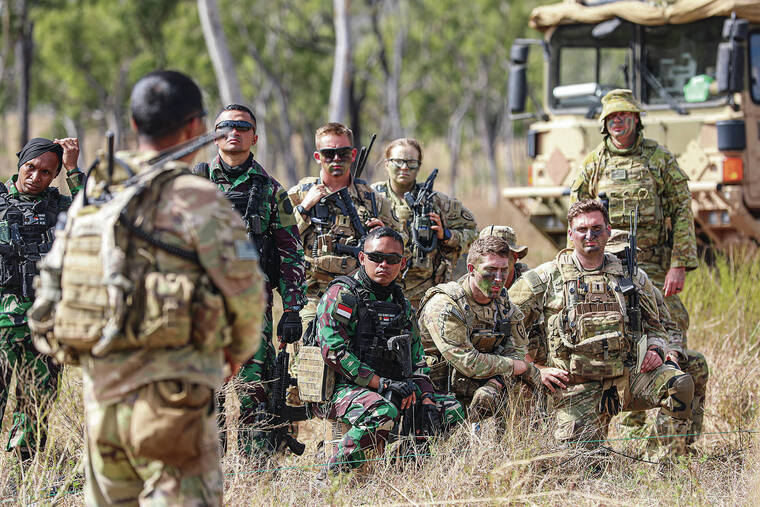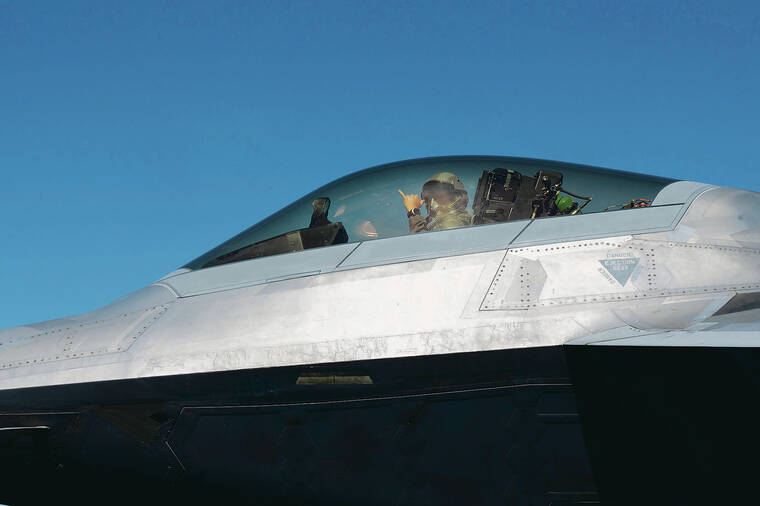The largest military exercise in the Pacific region this year is taking place in Australia, and Hawaii troops are playing a central role.
This year is the 10th iteration of the biennial exercise Talisman Sabre, and the largest yet. The exercise includes land warfare, naval maneuvers, amphibious landings and air operations. More than 30,000 troops from 13 nations are participating. Several Pacific island nations — including Papua New Guinea, Fiji and Tonga — are participating for the first time.
A Hawaii National Guard spokesperson said more than 300 personnel from the 199th Expeditionary Fighter Squadron, made up of a mixture of active-duty airmen and Hawaii Air National Guard members, are participating in Talisman Sabre along with 10 F-22 Raptor fighter jets from Oahu.
“Talisman Sabre has provided our two countries tremendous opportunities to work on our interoperability and agile operations,” said Col. Shane “Nuke” Nagatani, commander of the Hawaii National Guard’s 154th Wing Operations Group, in a statement to the Honolulu Star-Advertiser. “Our forces, whether from the active or reserve components, have overcome tremendous challenges and reset our expectations even higher, helping to ensure a peaceful and stable region with our partners.”
Working closely together is the goal. To that end members of the U.S. Army’s Schofield Barracks-based 25th Infantry Division’s 2nd Infantry Brigade Combat Team will operate under Australian command as part of the Australian army’s 1st Division, commanded by Maj. Gen. Scott Winter for the duration of the exercise.
The 25th Infantry’s commander, Maj. Gen. Joseph Ryan, said that for Americans who have sometimes become accustomed to thinking of themselves as the top dogs militarily, it’s a bit of a change of pace.
“We often do it in reverse, where we have no qualms or issues with receiving foreign forces, and oftentimes that’s become relatively the norm and we’re all relatively comfortable with it,” said Ryan, referencing cases in places like Iraq and Afghanistan when allied forces regularly operated under U.S. commanders. “I’m glad we’re doing it.”
RYAN SAID Australia is a natural partner for the United States. Both forces have worked together in several real-world operations over the past century, and the two are part of the Five Eyes, an intelligence-sharing alliance that also includes the United Kingdom, Canada and New Zealand.
During a visit Sunday to the exercise headquarters in Townsville, Australia, U.S. Defense Secretary Lloyd Austin, a former Army general, said in an address to troops and officers that “some of you I served with in combat. I was never in combat when I didn’t turn to my right or left and see Australian soldiers, sailors, airmen, as well as many of the allies and partners that are represented here today.”
Australian military personnel have already begun to increasingly integrate into American units and offices, especially in the Pacific.
Australian army Maj. Gen. Chris Smith serves as one of the deputy commanders of U.S. Army Pacific at Fort Shafter, and in January Air Vice-Marshal Carl Newman became the first Australian officer to be one of the deputy commanders of U.S. Pacific Air Forces at Joint Base Pearl Harbor-Hickam.
“It’s not uncommon to see an Australian officer serving in the Pentagon, at the War College, in various other places where you would just as normally see a U.S. officer,” Ryan said.
In 2021 the U.S., Australia and the United Kingdom signed the trilateral AUKUS defense pact. The agreement allows for closer cooperation among the three countries, particularly in developing and fielding nuclear- powered submarines. Australia is expected to buy up to five U.S. Virginia-class nuclear-powered submarines in the 2030s through the pact, which has an eye toward operations in the Pacific and China.
China has invested heavily in its navy, now the world’s largest by some estimates, and has stepped up its operations in disputed regions of the South China Sea. Beijing considers nearly the entire sea — a critical waterway that more than a third of all international trade travels through — to be its exclusive sovereign territory over the objections of its neighbors.
Some regional leaders worry that escalating tension could lead to blockades or a breakout of fighting at sea that could disrupt busy shipping lanes and upend the global economy.
The U.S. and Australia have simultaneously been sending diplomats to China while also doubling down on military alliances in what they say is an effort to deter China’s increasingly assertive military. Chinese officials have characterized military exercises by the U.S. and Australia around the region as “provocative.”
Ryan said he’s been reading press coverage of the current exercise and said that the Australian media has been “looking at Talisman Sabre through two different lenses. One is through this combined joint multinational alliance that is important from a deterrent strategy, but also as an affront to maybe a more heavily diplomatic approach in their view toward managing the People’s Republic of China, their largest trading partner.”
He asserted that there needs to be a balance and argued the exercise sends a signal that while countries in the region might prefer diplomacy, it should should also be understood they are “willing to exercise alliances and partnerships with other like-minded nations who respect the sovereignty of each other.”
THIS ITERATION of Talisman Sabre has been seen as particularly important by U.S. Army leaders, who planned and prepared for the exercise well in advance. U.S. Army Pacific is using it as one of the “exportable” rotations of its Joint Pacific Multinational Readiness Center, a series of training ranges in Hawaii and Alaska with rotations to one other country in the region each year.
In November a massive Navy cargo ship brought 500 pieces of Army equipment, vehicles and containers to Oahu. Between January and April the equipment went through agricultural inspections to make sure they weren’t carrying any pollen, animals or other organisms or material that could threaten ecosystems in Australia. The Army brought them the rest of the way to Australia with its own logistics support vessels, better known as LSVs.
The Army has a fleet of about 300 active and reserve watercraft, including tugboats, ferries and floating cranes, but currently just eight LSVs. The Army has been looking for ways to improve its maritime capabilities as the Pacific region has become the Pentagon’s top priority theater of operations.
Ryan said that throughout the process of getting equipment and soldiers to Australia, he often remarked to other officers that it would be a lot easier to hold the exercise somewhere else but that it created a realistic scenario for what the Army would face if it had to move forces during an actual crisis.
With such vast distances in between, there has been a debate within military circles about what role the U.S. Army can — or should — play in the Pacific.
Army officials have adopted the mantra that while the ocean is critical, “people live on the land.” On the ground in Australia nearly 10,000 troops from 10 countries are participating in what military officials are calling “the most comprehensive ground force- centered operation in Talisman Sabre history.”
Ryan said that working together in a training environment before times of crisis is critical to making joint operations work. It’s also the perfect time to give foreign officers like Winter the chance to lead U.S. troops and experiment with plugging different forces and commanders in and out of the force structure, because “if we’re not willing to do it in training, when would we be willing to do it?”




